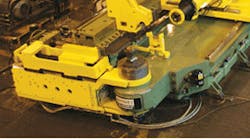Pines Technology, Westlake, Ohio, makes computer numerical control (CNC) tube benders for power generation, ship building, and heavy truck industries that cold bend pipe up to 14 in. in diameter, and hot (induction) bend pipe up to 48 in. The linear-guide carriages that move the pipe for bending carry pipe (to 1,450 lb) that exerts large moments (60,000 ft./lb of torque) on the carriage as it rotates lengths up to 8 m long.
85-mm profile rail guides with ball bearings originally used on Pines Technology's CNC-150 bending machine were robust but expensive and bulky. On subsequent versions of the CNC-150 and newer CNC-250, Pines switched to 65-mm 500 Series Thomson Roller linear guides, manufactured by Thomson Industries Inc., Wood Dale, Ill. The bearings have a dynamic load carrying capacity that's similar to that of the larger ball bearings — 295,000 N — but the former cost 30% less and are stock. The new guides also weigh 36% less than the old 85-mm profile rail guides, reducing overall machine weight.
How the pipe loader works
First, pipe is manually placed onto a bending machine's loader. Arms lower the material onto powered supports that feed each piece through a carriage. A laser identifies material ends and this information is used by controls to position it at the start of the bending process. The carriage then moves the part into position to be bent, and finally releases the part.
During bending, the tube is locked against a bend die by a clamp die. Then a pressure die contacts the tube's outside-diameter surface with a fixed load. Once the pressure die is locked, it travels with the part during the entire bending process.
Next, a swing arm rotates to bend the tube; booster force is used to apply a positive push to the pipe being bent to minimize distortion of the cross-section and reduce the amount of wall thinning along the outer radii of bends.
When the bend is completed, the carriage grips the pipe again and moves it to the next bend position. Here, the bearings must handle another load dynamic, during rotations between each bend.
“Our first customer for the CNC-150 machines had problems with another supplier's bending machines due to failures in the carriage bearings,” says Daniel Auger, Director of Engineering at Pines Technology. “We carefully selected 85-mm ball bearings for early versions of our CNC-150 machine and their performance was good, although cost was high. Later, we explored alternatives, including Thomson 500 Series roller profile linear guides.”
“The 65-mm 500 Series roller linear guide provides a similar load rating as the 85-mm diameter ball linear guide that we used on the first few machines, but at half the cost. We have used the 500 Series on all subsequent CNC-150 and CNC-250 machines and they have performed without failures or maintenance issues,” Auger concludes.
This application's details are provided by John Johnson of Thomson Industries Inc. For more information, call (540) 633-3549 or visit thomsonlinear.com.
